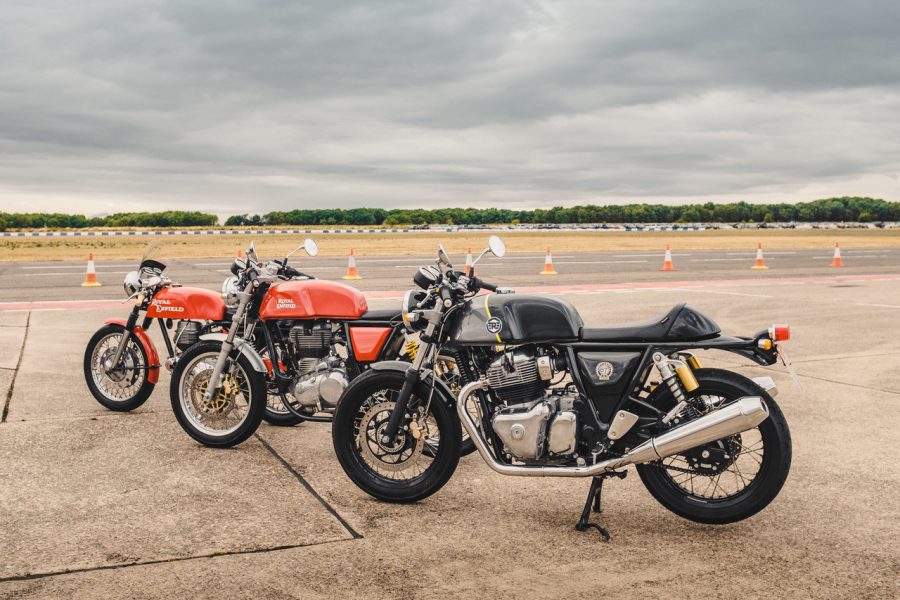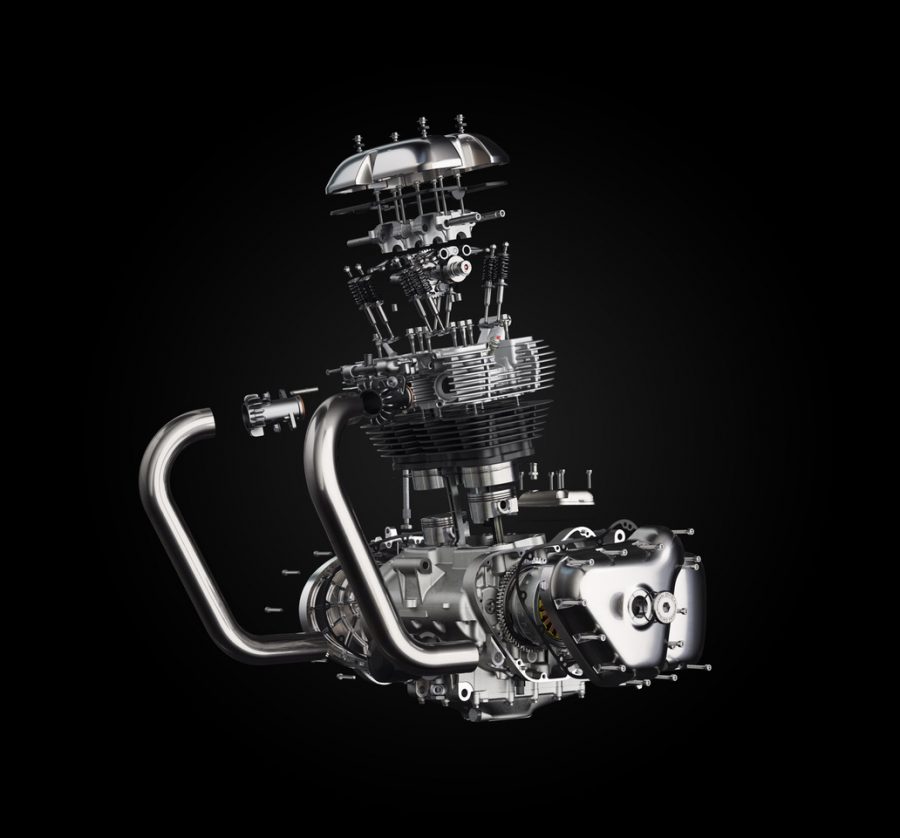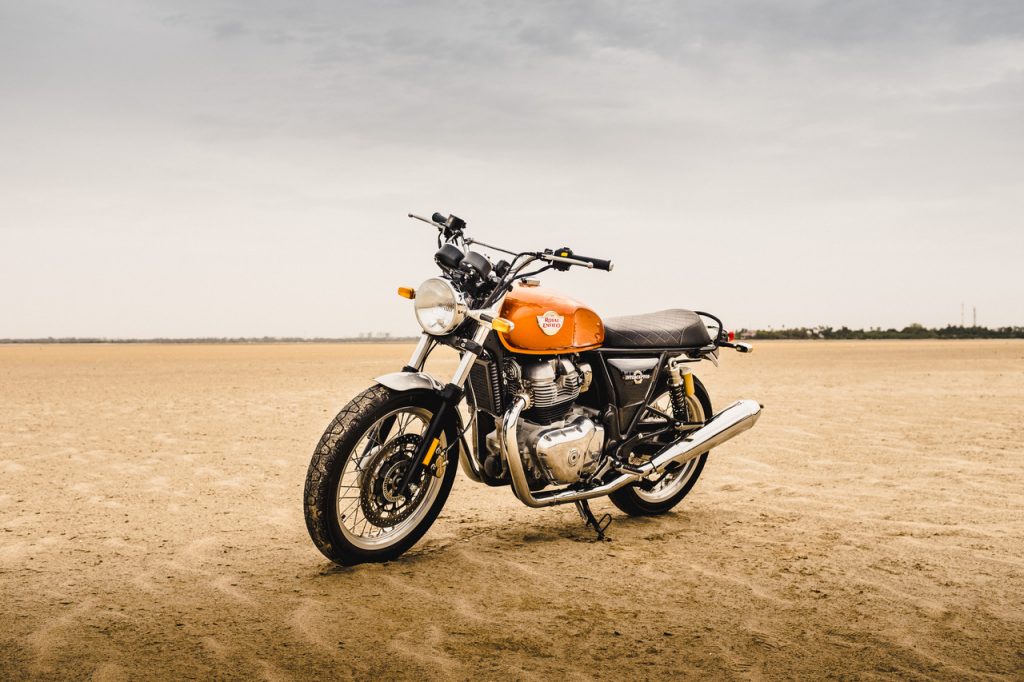Royal Enfield’s new Continental GT and Interceptor models, take us back to the marque’s golden era, a time when twin-cylinder engined motorcycles ruled the road and race tracks of the world.
AMCN editor Chris Dobie spent two days riding the all-new Royal Enfield 650 Twins on the sensational roads that snake through the state parks around Santa Cruz, California. His first impressions are that the Indian-owned British marque has a couple of winners on its hands.
The Continental GT and Interceptor are powered by the company’s all-new single overhead cam, four-valves per cylinder 650 (648cc) parallel twin-cylinder, air/oil cooled engine. Both models share the same steel, double-cradle chassis design, conventional 41mm fork, gas-charged piggyback reservoir twin shocks (with five-stage preload), and a Brybe braking package. The GT is the café racer, with its single seat, 12.5L fuel tank with cutouts, clip-on style handlebars and black rims for its alloy spoked wheels. The Interceptor is a roadster, with a braced, 70’s scrambler-style handlebar, slimmer but larger-capacity 13.7L fuel tank, larger flat seat with room for a pillion, centre stand and polished alloy spoked wheels.

Attention to detail is evident everywhere you look on the bikes, including the way the oil cooler and lines match up perfectly with the down tubes of the frame, making the cooler much less noticeable. I wasn’t a fan of the large plastic lens and bulb tail light and indicators on the 2012 Royal Enfield GT 535, and even the nice lines of the new GT and Interceptor can’t make up for using a similar set up this time. The simple two-clock analogue dash features a rev counter and a speedo with a built-in LCD screen displaying odometer and trip metres. It’s all easy to read and works with the retro styling of the bikes.
The world launch was split into two full days of riding, providing enough time to evaluate each machine thoroughly. First up was the Continental GT. The lengthy reach to the clip-on bars is surprising. Despite being set well above the top triple clamp, a hunkered down position is taken once riding. The singles seat is quite firm, and its 793mm seat height and a slim design allow easy reach to the ground. Even with the stock exhaust, the sound from the 270-degree crank firing sequence is an enjoyable angry burble.
The seating position of the GT places the rider’s bodyweight on the handlebar providing a lot of feel for what the front-end is doing. The small seat, with its limited padding, does similar at the rear. Riding at a relaxed pace, the 41mm non-adjustable conventional-style fork absorbs bumps in the road easily, while the rear, which feels a little more heavily sprung, does the same. Once the pace quickens, the twin rear shock design does begin to reveal why progressive rate linkages and mono shocks replaced the idea decades ago. The tight springs make rebound a little too quickly causing the bike to bounce through dips, but to its credit, there was no bottoming out despite the short 88mm stroke length. The bike feels rigid, but the riding position is comfortable.
The fast change of directions required through the long sections of flowing S-bends on our test route highlighted the brilliant engineering work that has gone into the new chassis. It handles like a modern machine yet runs on 18-inch wheels for a truly retro look.

ByBre, Brembo’s Indian arm, supplies the brakes. Up front, the stopping power of the single twin-pot calliper and a 320mm disc is great but would benefit from a little more initial bite. There’s excellent feedback through the lever.
From throttle opening through to the 7500rpm rev limiter, the delivery of power from the 649cc parallel-twin engine is impressive. It may only have 35kW and 52Nm, but its spread right across the rev range, providing a predictable surge of torque.
A few times I found myself sitting between 100-110km/h in fourth gear, enjoying the sound and performance from the 270-degree crank parallel twin, as it hummed along at 5000rpm. Clicking up two gears to the overdrive sixth for freeway riding will reveal an engine happy to sit on 120km/h all day, and while a click back to fifth is required to gather momentum quickly, the ton is achieved with ease.

Day two saw me on the Interceptor. You would think by adding a different seat, tank and handlebar to a motorcycle would make it feel pretty much the same, but the Continental GT and Interceptor have different personalities. The longer, higher (804mm) and a more padded seat on the Interceptor provide better comfort than the GT, and the high-set handlebar changes the rider triangle, while its width alters the leverage required for steering. Both models have the same, comfortable peg-to-seat length, but the additional room to move on the Interceptor makes it feel longer. The Interceptor is also four kilograms heavier at a claimed 202kg (kerb/no fuel). Cruising through the main street of Santa Cruz on the Interceptor, sitting high and upright, it just felt, sounded and looked right. Here is a bike that is going to be just at home handling mid-week urban duties as it will be taking a weekend cruise to the beach.
The Interceptor is a heap of fun to ride, but I felt the higher and wider bar diluted the nice front-end feel I’d had on the GT. And while the padded seat of the Interceptor reduced the bounce at the rear-end, I preferred the single seat of the GT. It’s horses for courses, others felt the opposite.
The two new models are expected to arrive in Australia early 2019 with Urban Moto Imports expected to announce pricing closer to the arrival date, but fingers are crossed for a sub $10K price tag for the base model Continental GT and Interceptor. The custom paint and chrome tank models will cost a few hundred dollars more.
When Royal Enfield released its new 650 models at EICMA 2017, the planned world launch was set for April 2018, but it took until September for the bikes to be ready. Everyone concerned with the project knew the importance of getting it right, making sure nothing was rushed, and every part of the bike was as good as it could possibly be. The end result appears to be exactly that.
By Chris Dobie












